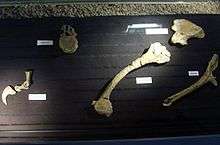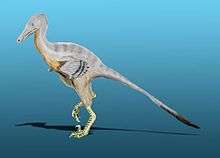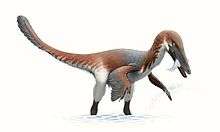Unenlagia
| Unenlagia Temporal range: Late Cretaceous, 89 Ma | |
|---|---|
 | |
| Illustration of known material of U. comahuensis | |
| Scientific classification | |
| Kingdom: | Animalia |
| Phylum: | Chordata |
| Class: | Reptilia |
| Clade: | Dinosauria |
| Order: | Saurischia |
| Suborder: | Theropoda |
| Family: | †Dromaeosauridae |
| Subfamily: | †Unenlagiinae |
| Genus: | †Unenlagia Novas & Puerta, 1997 |
| Species | |
| |
Unenlagia (meaning "half-bird" in latinized mapudungun) is a genus of theropod dinosaur from the Late Cretaceous of Argentina.
The genus Unenlagia has been assigned two species: U. comahuensis, the type species described by Novas and Puerta in 1997, and U. paynemili, described by Calvo et al. in 2004.
Discovery and naming
In 1996 in the Neuquén province of Argentina a skeleton of a theropod was discovered in the Sierra del Portezuelo and reported the same year.[1] In 1997 Fernando Emilio Novas and Pablo Puerta named and described Unenlagia comahuensis. The generic name is derived from Mapuche uñen, "half", and lag, "bird", in reference to the fact that the describers considered the species to be a link between birds and more basal theropods. The specific name refers to the Comahue, the region the find was made.
The holotype specimen, MCF PVPH 78, was uncovered in layers of the Portezuelo Formation dating to the Coniacian. It consists of a partial skeleton lacking the skull but including vertebrae, a sacrum, ribs, chevrons, a scapula, a humerus, a partial pelvis, a femur and a tibia.

In 2002 near the Lago Barreales a second skeleton was uncovered and reported in 2003.[2] In 2004 it was named and described by Jorge Calvo, Juan Porfiri and Alexander Kellner as a second species: Unenlagia paynemili. The specific name honours Maximino Paynemil, the chief of the Paynemil community. The holotype is MUCPv-349, a partial skeleton consisting of a humerus and two pubes. Several paratypes were also assigned: MUCPv-343, a claw; MUCPv-409, a partial ilium; MUCPv-415, a phalanx and MUCPv-416, a vertebra.[3]
Some researchers consider Neuquenraptor to be a junior subjective synonym of Unenlagia.[4]
Description

The body length of Unenlagia has been disputed, due to the fact that only the leg length is well known and it is uncertain whether this should be extrapolated using the proportions of the low-slung Dromaeosauridae or the long-legged basal birds. Estimates have thus varied between a length of 3.5 metres and a weight of 75 kilogrammes on the one hand,[5] and a length of just two metres on the other.[6] Likewise, the interpretation of the head form has changed from a shorter-snouted dromaeosaurid condition to the elongated shape known from the later discovered related genera Buitreraptor and Austroraptor.
Novas and Puerta found that the pelvic region of Unenlagia, especially the form of the ilium, was very similar to that of the early bird Archaeopteryx.[7] The shoulder girdle of Unenlagia was originally interpreted as if it was adapted for flapping, with a flat scapula positioned on top of the ribcage, making the shoulder joint point more laterally. However, in 2002 Kenneth Carpenter pointed out that this would imply that the shoulder-blade was dorsoventrally flattened instead of laterally as with other theropods and that it thus were more likely the scapula was located on the side of the ribcage.[8] This conformed to a later hypothesis by Philip Senter that non-avian theropods like Unenlagia were unable to lift their forelimbs above their back, as even would still have been the case for the basalmost bird Archaeopteryx.[9] South-American workers have remained unconvinced though, countering that a laterally positioned scapula would make the coracoid of Unenlagia jut into its ribcage, which seems anatomically implausible.[6]
At at least 3 meters long, Unenlagia was probably too big to fly.
Phylogeny
Novas and Puerta in the original description considered Unenlagia a sister taxon of the birds, which would make it a basal member of the Avialae sensu Gauthier 1986.
However, in 1999 Mark Norell and Peter Makovicky stated that Unenlagia was a member of the Dromaeosauridae.[10][11] Unenlagia would have belonged to the extremely bird-like Gondwanan clade of dromaeosaurids called the Unenlagiinae, and be closely related to species such as Buitreraptor and Neuquenraptor (which might be the same species as Unenlagia). Makovicky et al. in 2005 also recovered the 'flying raptor' Rahonavis as a member of this group, which would mean that either Unenlagia is secondarily flightless, having evolved from flying, Rahonavis-like ancestors, or that bird-like flight evolved at least twice.[12] Norell et al. in 2006 also found Rahonavis to be the sister taxon of Unenlagia.[13]
This position has not been unanimously accepted. In 2011 Novas and Federico Agnolín published a study in which an Unenlagiidae was positioned within Avialae.[14]
See also
References
- ↑ F.E. Novas, G. Cladera, and P. Puerta, 1996, "New theropods from the Late Cretaceous of Patagonia", Journal of Vertebrate Paleontology 16(3, suppl.):56A
- ↑ Calvo, J.O., Porfiri, J.D. and Kellner, A.W.A., 2003, "A close relative of Unenlagia comahuensis (Theropoda, Maniraptora) from the Upper Cretaceous of Neuquén, Patagonia, Argentina", 18º Congresso Brasileiro de Paleontologia, Brasilia, Resumos: 82-83
- ↑ Calvo, J.O.; Porfiri, J.D.; Kellner, A.W. (2004). "On a new maniraptoran dinosaur (Theropoda) from the Upper Cretaceous of Neuquén, Patagonia, Argentina". Arq. Mus. Nacional. Rio de Janeiro. 62: 549–566.
- ↑ A. H. Turner, S. H. Hwang, and M. A. Norell. 2007. "A small derived theropod from Öösh, Early Cretaceous, Baykhangor Mongolia". American Museum Novitates 3557: 1-27
- ↑ Paul, G.S., 2010, The Princeton Field Guide to Dinosaurs, Princeton University Press p. 138
- 1 2 F.A. Gianechini & Sebastian Apesteguia, 2011, "Unenlagiinae revisited: dromaeosaurid theropods from South America", Anais da Academia Brasileira de Ciencias 83(1): 163-195
- ↑ Novas, F.E.; Puerta, P.F. (1997). "New evidence concerning avian origins from the Late Cretaceous of Patagonia". Nature. 387 (6631): 390–2. Bibcode:1997Natur.387..390N. doi:10.1038/387390a0.
- ↑ Carpenter, K. 2002. "Forelimb biomechanics of nonavian theropod dinosaurs in predation". Senckenbergiana Lethaea 82: 59–76
- ↑ Senter, P. (2006). "Scapular orientation in theropods and basal birds, and the origin of flapping flight." Acta Palaeontologica Polonica, 51(2): 305–313.PDF fulltext
- ↑ Norell, M.A.; Makovicky, P.J. (1999). "Important features of the dromaeosaur skeleton II: information from newly collected specimens of Velociraptor mongoliensis". American Museum Novitates. 3282: 1–45.
- ↑ M.A. Norell and P.J. Makovicky, 2004, "Dromaeosauridae". In: D.B. Weishampel, P. Dodson, and H. Osmolska (eds.), The Dinosauria (second edition). University of California Press, Berkeley pp. 196-209
- ↑ Makovicky PJ, Apesteguía S, Agnolín FL (2005). "The earliest dromaeosaurid theropod from South America". Nature. 437 (7061): 1007–1011. Bibcode:2005Natur.437.1007M. doi:10.1038/nature03996. PMID 16222297.
- ↑ Norell, M.A.; Clark, J.M.; Turner, A.H.; Makovicky, P.J.; Barsbold, R.; Rowe, T. (2006). "A new dromaeosaurid theropod from Ukhaa Tolgod (Omnogov, Mongolia)". American Museum Novitates. 3545: 1–51. doi:10.1206/0003-0082(2006)3545[1:ANDTFU]2.0.CO;2.
- ↑ Agnolin, F.L.; Novas, F.E. (2011). "Unenlagiid theropods: are they members of the Dromaeosauridae (Theropoda, Maniraptora)?". Anais da Academia Brasileira de Ciências. 83 (1): 117–162. doi:10.1590/S0001-37652011000100008.

